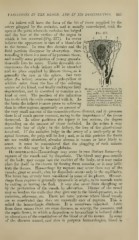Page 675 - My FlipBook
P. 675
VARIATIONS IN THE BLOOD, AND IN ITS DISTRIBUTION. 68o
An infarct will have the forni of the bit of tissne supplied by the
artery plugged by the embolus, and is usually cone-shaped, with the
apex at the point Avhere the embolus has lodged
Fig. 37
and the base at the surface of the organ in
which it has occurred (Fig. 377). In recent
infarcts the appearance is that of a blood-clot
in the tissues. In time this shrinks and the
fluid portions disappear by absorption. Sur-
rounding it there is a zone of hypeneniic tissue,
and usually some projection of young granula-
tion-cells into its mass. Under favorable cir-
cumstances the whole infarct will be absorbed
and its place supplied by fibrous tissue, as is
generally the case in the spleen. But very
often the infarct becomes of a pale-yellow or
whitish color, from the loss of the coloring
matter of the blood, and finally undergoes fatty
Diagram of a nemorihnf;ic In-
degeneration, and is absorbed or remains as a farct : a, artery obliterateJ by
aneinbolus(f);'i;,vein filled with
kind of cyst. The position of the infarction a second iry thrombus {(/i); 1,
In centre of infarct which is he-
has to do with the evils connected with it. coniiiig disintegrated ; 2, area
the brain the infarct is more prone to softening of extravasation ; o.areaof col-
lateral hyperseniia (O. Weber).
than in other regions, apparently on account of
the very small amount of the connective-tissue element, and its presence
there is of much graver moment, owing to the importance of the tissue
destroyed In other positions the injury is less serious, the degree
depending on the amount of tissue included. In the retina it may
cause the loss of sight; in the kidney, the loss of the gland-tissue
involved. If the embolus lodge in the artery of a tooth-pulp at the
apical foramen, the pulp will be lost ; and, as in this position the fluids
are not readily absorbed, alveolar abscess is sooner or later likely to
occur. It must be remembered that the plugging of such minute
arteries as this may be by oil-globules.
He:morrhage.^—Hemorrhage may occur in two distinct forms— by
rupture of the vessels and by diapedesis. The blood may pass outside
of the body, may escape into the cavities of the body, or it may make
})lace for itself in the tissues by forcing them asunder, or it may infil-
trate the tissues. Hemorrhage by rupture may occur from any of the
vessels, great or small ;. that by diapedesis occurs only in the capillaries.
The latter has already been considered in some of its phases. Hemor-
rhage tVom rupture is generally traumatic in origin, as in wounds made
by cutting or tearing the flesh. It may also occur from sloughing or
by the perforation of the vessels by ulceration. Disease of the vessel
may so weaken the walls that they give way to the blood-pressure, as in
aneurism, atheroma, etc. There are some persons whose blood-vessels
are so constituted that they are unusually easy of rupture. This is
called the hemorrhagic diathesis. It is sometimes inherited. Aside
from these causes there are some diseases, as scurvy, the anremias, and
the septic fevers, in which a disposition to hemorrhage is induced either
by alterations of the constitution of the blood or of the tissues. In some
of the diseases named, and also in purpura hemorrhagica, blood is


